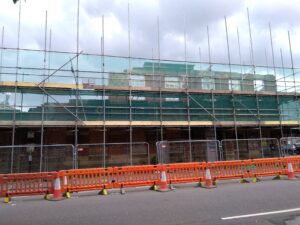We have recently received confirmation that yet another irreplaceable and unique heritage building has been lost in Sheffield.

Old Coroner’s Court, Nursery St, Sheffield: cc British Newspaper Archive 1914
The Old Coroner’s Court, as it was known, stood on Nursery Street in the city, from its construction in 1913 until its recent demolition by the current owners. Sheffield’s first purpose-built mortuary and coroner’s court was built on Plum Lane in 1884 but, by the early 20th Century, the building was no longer satisfactory and, beginning in 1913, a new coroner’s court with a mortuary to the rear was built on Nursery Street to designs by the city architect F E P Edwards. It comprised a court room furnished in oak, a mortuary and viewing chapel, coroner’s room, witnesses’ waiting room, police surgeon’s room, post-mortem room, stabling and a caretaker’s house.
The Old Coroner’s Court represented a period of municipal expansion of city infrastructure in the Edwardian period. In appearance and, as an historic building built to house a very specific purpose, it clearly provided both visual and historic interest to the local streetscape. It’s position on Nursery Street was probably motivated by its proximity to the city centre and a desire to regenerate an area of mostly low quality housing. The building was an exemplar of its period, using brick, stone and faience with a design that drew upon the Gothic revival, Queen Anne and Baroque traditions of the previous century. The building provided a strong on street presence, built up against the street edge and forming an architecturally distinct asset within an area now largely characterised by industrial buildings.
The demolition followed a now sadly familiar tale of failures within the planning system as, although originally rejected by the Sheffield Planners, a planning inspectorate decision overruled them and permission to demolish was given. Since then there was a stay of execution as a number of poorly thought out redevelopments were rejected by city planners. The last real opportunity to save the building was lost when the City Council missed an opportunity to create a Conservation Area for Castlegate that would have included this site.

Sheffield Old Coroner’s Court Demolition, 17/6/2024, Courtesy of JUH Sheffield
Another sad loss of a unique piece of the city’s Edwardian heritage to be replaced by a modern box with little merit.



